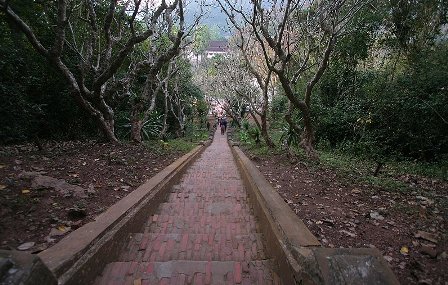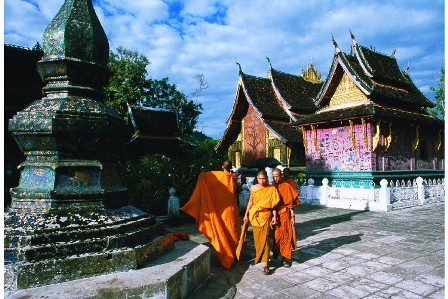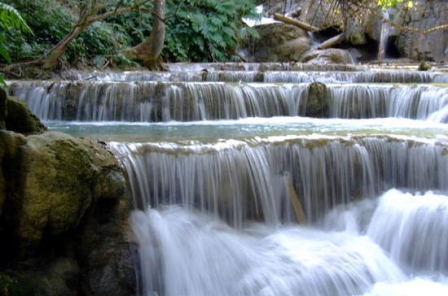
Set at the confluence of two rivers that almost surround the town, and
beneath a temple-topped hill, Luang Prabang is a wonderful patchwork of
traditional Lao wooden houses and hints of European architecture - reminders of
when Laos
was part of the French colony of Indochine. Golden-roofed wats (temples),
decorated with mosaics and murals of the life of Buddha, sit under the gaze of
wrap-around teak balconies and 19th century shuttered windows. All of this is
set against a backdrop of verdant greenery and rugged mountains.
As a visitor, you cannot help but be amazed by the tidiness and
cleanliness of perhaps the most charming city in all of Southeast
Asia. With UNESCO so closely involved and a largely responsible
group of local business owners, the pressures of mass tourism development have
been held at bay, but for how much longer remains to be seen. Restaurants in
the main street cater for luxury tourists. More typical Lao venues can still be
found along the Mekong.
Mount Phousi

These temples were recently constructed in comparison to the more
historic Wat Visoun and Wat Xieng Thong. Situated at the top of 100 metre
Phousi, the pinnacle of the hill is host to many temples.
The gilded stupor at the top of the hill is built on a huge rock and
glistens brilliantly over the horizon. The abandoned temple of Wat Pa Huak
resides a short walk away from the top with a wide terrace that overlooks the
museum.
Royal Palace
Museum
Built as a residence for King Sisavang Vong and his family in 1904 by
the French, like Wat Xieng Thong the palace was built on the riverfront, to be
in direct view of arriving official visitors. Displaying traditional Laos motifs
fused with French beaux-art styles, many of the rooms have been preserved since
the day of the revolution when the royal family was forced into exile by the
Pathet Lao.
Locals believe the palace to be haunted by ghosts and few will venture
inside after dark. Inside, the walls feature murals and paintings depicting
typical Laos
life. It is advisable to visit the place first to stock up on so.
Wat Wisunarat (Wat Visoun)
Built in 1513, this is the oldest temple in Luang Prabang. Originally
built with wood the temple was remade with brick and stucco after it was set
fire to by Black Haw riders in 1887. The sloping-style of the roof is a
distinctive feature due to the fact that it is a not a common Laotian design
trait. Inside the building is a stupa that was commissioned in 1503, complete
with small Buddha images made from precious materials and sacred objects, many
of which were stolen when the Haw invaded the temple.
Wat Xieng Thong

Wat Xieng Thong is a masterpiece of Buddhist architecture from the 16th
century, impressing visitors with its golden facades and mural paintings. The
temple was used for the highest royal ceremonies and to temporarily house the
bodies of deceased kings. Built in 1560, by King Setthathirat, Wat Xieng Thong
remained in royal benefaction until 1975. Placed on the northern tip of Luang
Prabang, the magnificent structure is fringed by the river.
The sim (main building) is thought to represent classic Luang Prabang
architecture with its sweeping roofs. The rear wall of the sim has an
interesting 'tree of life' mosaic set on a red background and the temple's
interior is stenciled with gold images of the former King Chanthaphanit (of
whom no written history exists). A smaller adjoining building, houses a
reclining Buddha created in classic Lao style - a rarity.
NEARBY
Bear Rescue Centre — located adjacent to the way to the Kuang Si
Waterfalls, the Bear Rescue Centre has a enclosure for endangered Asiatic Black
Bears that have been rescued from poachers.
Kuang Si Falls, Luang Prabang

Kuang Si Falls — a large multi-stage waterfall, accessible by boat or truck hire, some
29 km south of Luang Prabang. You can also rent a motorbike to transport
yourself there. There are food and tourist stalls outside the waterfalls. It is
worth putting a whole day aside (or more) for seeing these because they are a
great place to relax and meet other travellers. There are multiple pools at
different levels, all of which are reportedly safe to bathe in, and are
extremely picturesque. Shared tuk tuks to go there charge about 30 to 50,000
Kip (cheapest seems to be near slow boat pier, though you can get them for
40,000 kip near JoMa Bakery). You may have to wait until the Tuk Tuk fills up.
Tuk Tuks are legally only allowed to take six people, and there is a checkpoint
at the falls - so some drivers may try to hide a 7th person in the front seat.
Private tuk tuk will cost you around 100 to 150,000 kip - after some haggling.
Tad Sae Waterfalls — step waterfalls which are not as big as
Kuang Xi, but very beautiful. You can bathe there and elephant rides are
available. Entrance is 15,000 kip and you have to river boat to reach the
place.
Pak Ou Caves — the famous "Buddha caves" are
north of town on the Mekong and can be reached
by road (approx 1 hr) or river boat (around 1.5 hrs). Alternatively, you can
hire canoes and a guide for the day, which would allow you to view the
beautiful scenery and visit the caves without throngs of other tourists. It's
also possible to finish the trip at the 'whisky village' where the local Laolao
(lao rice spirit) is made. There are two caves - one on the entry level and
another - the upper caves - on top of the hill. A very steep climb, but worth
the efforts. A candle or torch recommended to see the upper cave, as it is
dark. Simply cross the river for for 3,000-5,000 kip, walk up the hill and turn
to the right crossing the primary schools to find your way to the caves.